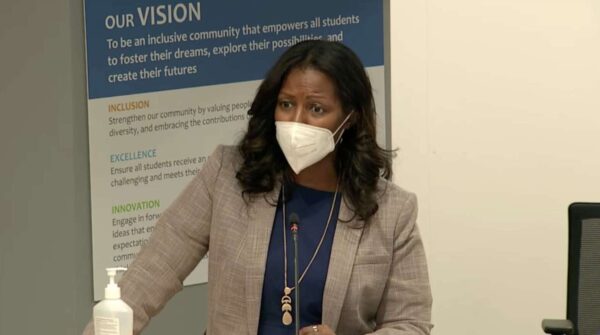
(Updated at 12:05 p.m. on 2/3/21) During the Arlington School Board meeting last night, public school administrators made the case for why the fledgling, controversial in-house virtual learning platform now deserves better grades.
Last fall, Arlington Public Schools launched its Virtual Learning Program for families with reservations about in-person school amid the pandemic or whose students preferred online classes.
But the program got off to a rocky start due to a teacher shortage and lack of administrative support. Parents said many students were sitting unsupervised in virtual “waiting rooms,” doing individual work overseen by assistants, struggling to get into third-party online classes and not getting needed special-education services.
Teachers, meanwhile, reported getting switched to different subjects on short notice, scrambling to find instructional resources, not knowing who to talk to and feeling unsupported.
“We were not pleased with the rocky start and we wanted to make sure things were moving on a little more smoothly by about this time of the year,” School Board Chair Barbara Kanninen said during the meeting.
Yesterday, APS administrators outlined what it’s done since then to extinguish the VLP’s myriad little fires. They didn’t, however, address the rumors swirling of an uncertain future for the VLP beyond the 2021-22 school year amid dropping enrollment, mostly at the elementary level, as families transition back to their home school or leave the school system. The program had 282 elementary students in October and has 247 students today.
Kimberley Graves, APS’s chief of school support, said communications with parents and home schools have improved under the new principal Danielle Harrell, but that the connection between the online and the brick-and-mortar school still needs work — an assessment shared by some teachers.
“While there’s been tremendous support from home schools, there is still work to be done to ensure that our students in the VLP have a direct connection to their home schools and really define what those connections look like,” Graves said.
A parent from the VLP Parents’ Coalition echoed Graves’ evaluation of the program.
“Although VLP has made good progress, there are still a number of challenges to be addressed, and the VLP Parents Coalition looks forward to continuing our collaboration with APS to ensure the program is a successful option for those that need and want it,” the parent, who wished to remain anonymous, told ARLnow.
Those connections are crucial because, compared to the overall APS student body, the VLP has higher proportions of students who received additional services from their brick-and-mortar buildings pre-pandemic. Sixty percent of students are eligible for free- or reduced-price lunch, while 24% are special-education students and 36% are English-language learners.
Graves outlined a few bright spots: Harrell was onboarded with the temporary help of three retired principals who also addressed the program’s immediate concerns. She now meets regularly with the school systems’ other principals. Every vacant instructional position is now filled and teachers had opportunities last November to access instructional training.
APS is calling more families of students who don’t log in frequently, but Graves said, this isn’t “catching all students.” Meanwhile, those students who were teacher-less in September won’t receive first-quarter grades in those classes.
Going forward, Graves said APS will make sure more students can participate in extracurricular activities and athletics through their home schools and increase the number of middle- and high-school classes taught by live APS teachers.
All elementary classrooms are taught by APS teachers but third-party vendors such as Virtual Virginia, the state’s online learning platform, are used in the middle and high school levels, she said.
More than 70% of middle school classes are taught by live APS teachers; at the high school, two-thirds of classes are taught by third-party vendors to give students a wide variety of courses to choose from.
Both Kanninen and the board’s newest member, Mary Kadera — the program’s board liaison — had encouraging words for the progress made.
“It’s a very different picture and discussion from what we had in the fall,” Kanninen said. “We look forward to continuing to support you in this work.”
Kanninen requested a final budget for the program. Its cost and funding source, American Rescue Plan Act funding, are a frequent critique from pro-open schools group Arlington Parents for Education.
Kadera, who helped VLP families last fall coalesce and bring their concerns to school administrators when she was still on the County Council of Parent-Teacher Associations, commended APS for admitting its mistakes and trying to improve.
“I think it is impossible to expect that our school system will get everything right, every time. I think there is great power and humility in admitting when we haven’t hit the mark,” Kadera said. “Although this program had a bumpy start, this is an authentic model of community engagement and ongoing, true collaboration between the community and school system.”
APS is promoting transitioning to the virtual program during the first two weeks of February.

